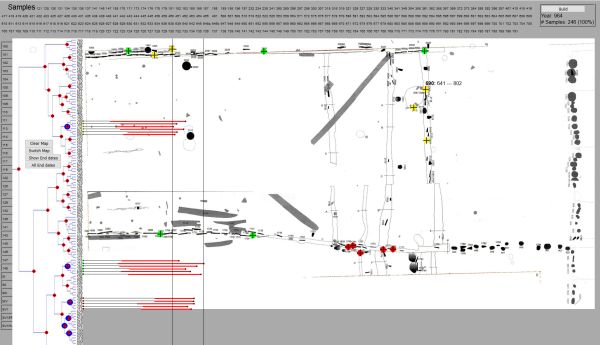Vincent MOM | Joachim SCHULTZE | Sigrid WROBEL | Dieter ECKSTEIN
(Digital Preservation Projects Foundation, Rotterdam, The Netherlands)
Keywords: Hedeby harbour, dendrochronology, visualization, Viking age
Abstract:
The harbour facilities near the Viking city Hedeby in the north of Germany developed considerably during the period between 700 and 1000 AD. In 1979/80, a large research excavation was undertaken by K. Schietzel that exposed about 97% of the harbour area (2236 m2). 2044 timbers and 1641 post holes were uncovered which resulted in 264 dateable samples (Kalmring 2010).
Information technology provides tools to combine and transform data from different sources into relevant information, and when ‘dating-data’ is available, then this makes it possible to introduce dynamics into the resulting visualizations.
For the harbour of Hedeby we developed a visual tool, using the available dateable wood samples: their year ring patterns were compared, one by one, to calculate the ‘distance’ of each pair of samples: the smaller this distance, the larger the chance that two samples are from the same tree, which provides interesting information about wood usage strategies. The resulting distance matrix was used to do a clustering of the samples. A second source of data was the end date (felling date) of the samples. And the third was the find spot of the sample, as indicated on the excavation maps.
The tool offers a number of basic functions like showing (clusters of) samples on different excavation maps. Apart from that, the tool shows the dynamics of the harbour’s development: one can specify a period’s start- and end-date and the tool will show, year by year, the harbour’s extensions. Especially in the years 881 and 885 AD substantial developments took place.
Relevance for the conference: A new tool that dynamically visualizes the development of the harbour of an important early-medieval settlement, based on the integration of different data sources.
Relevance for the session: The dynamic developments show the different periods of increased activities over time
Innovation: Combining the clustering of wooden samples, based on their year ring patterns, combined with other other data to search for ‘same tree’ samples is new
References:
• Allocating Archaeological Wood Samples to a Common Source Tree and Its Use for Analyzing Wooden Settlement Structures (Mom, Schultze, Wrobel and Eckstein, CAA 2009)
• Der Hafen von Haithabu (Kalmring, 2010)



